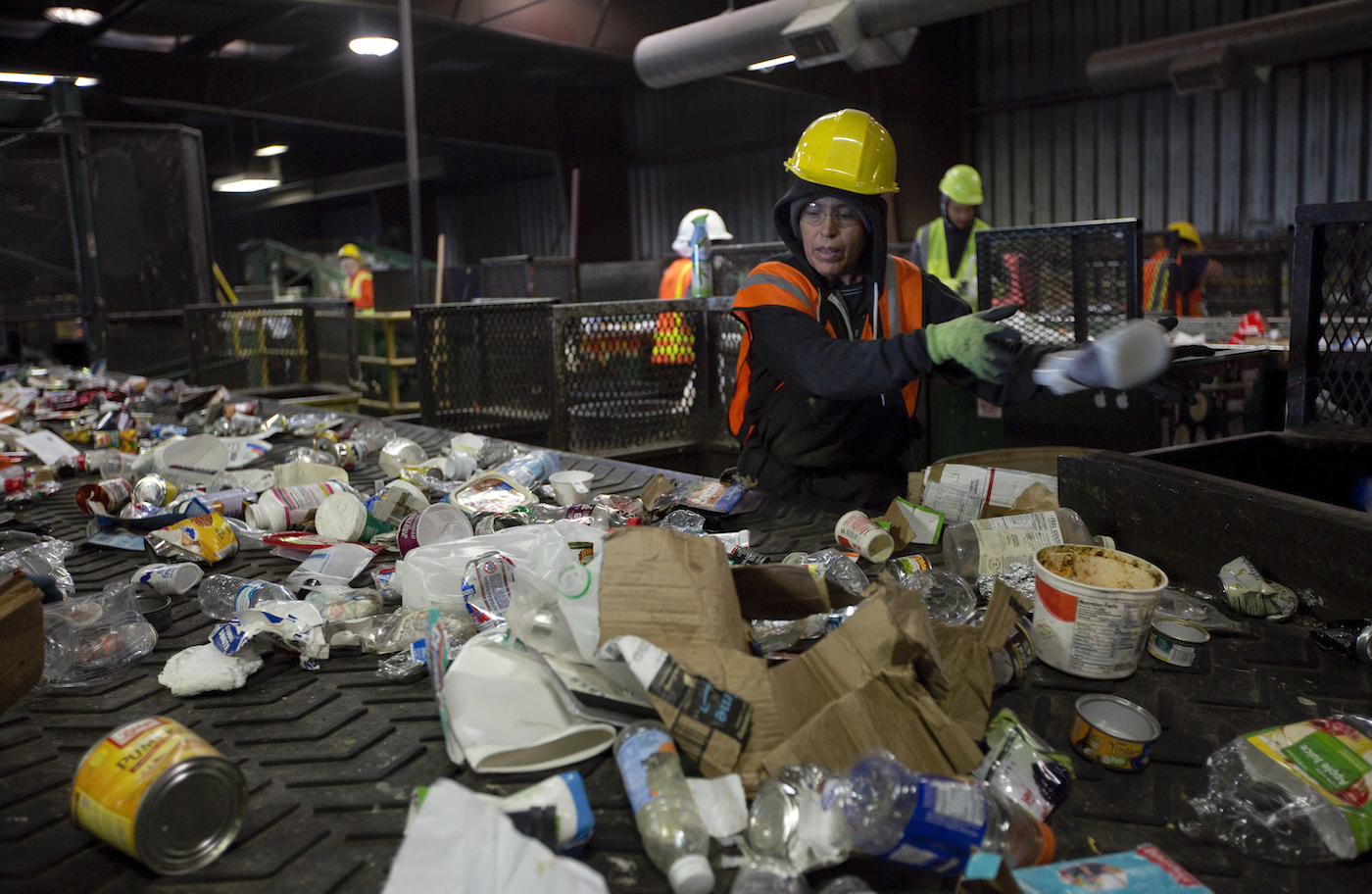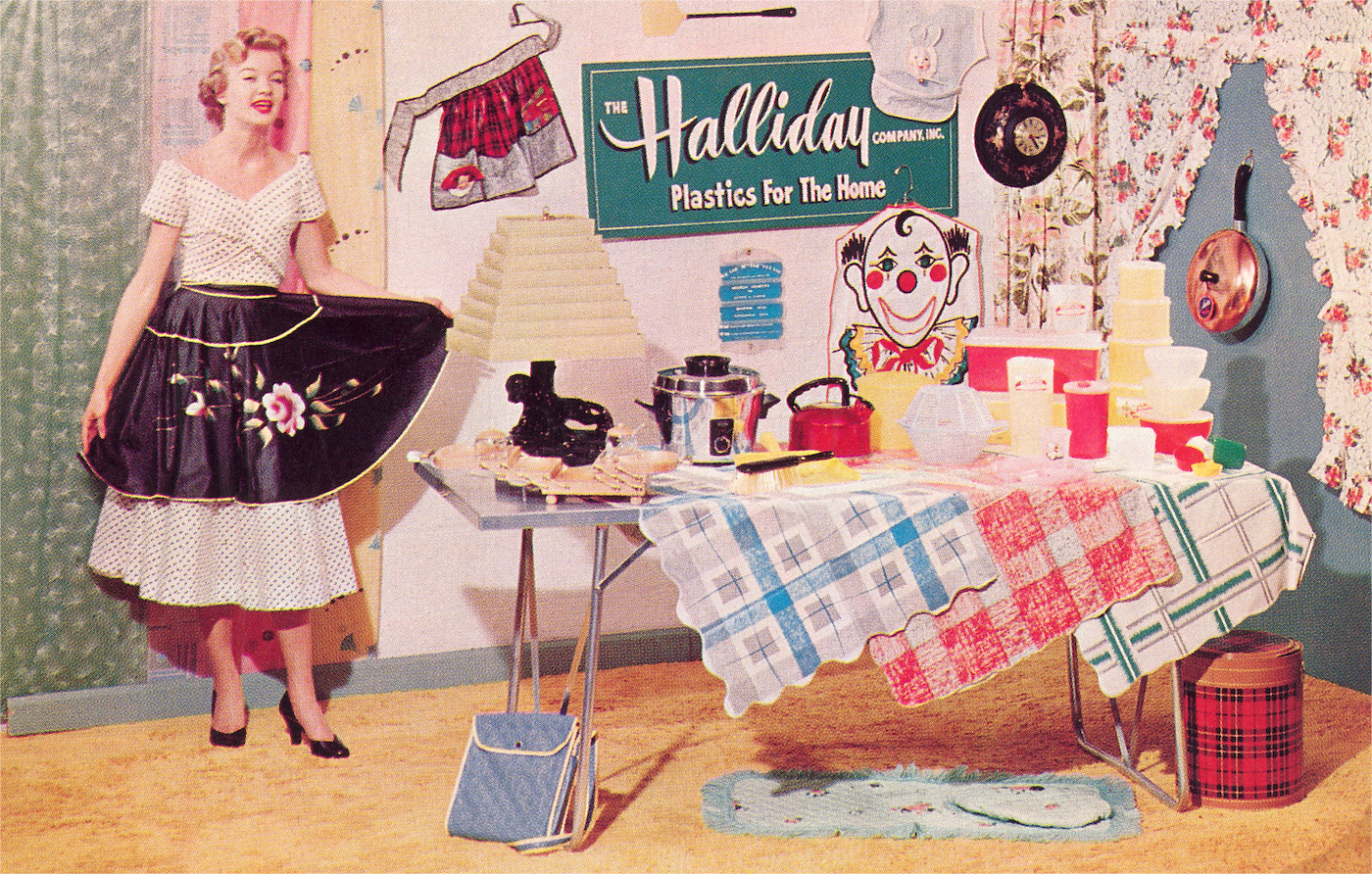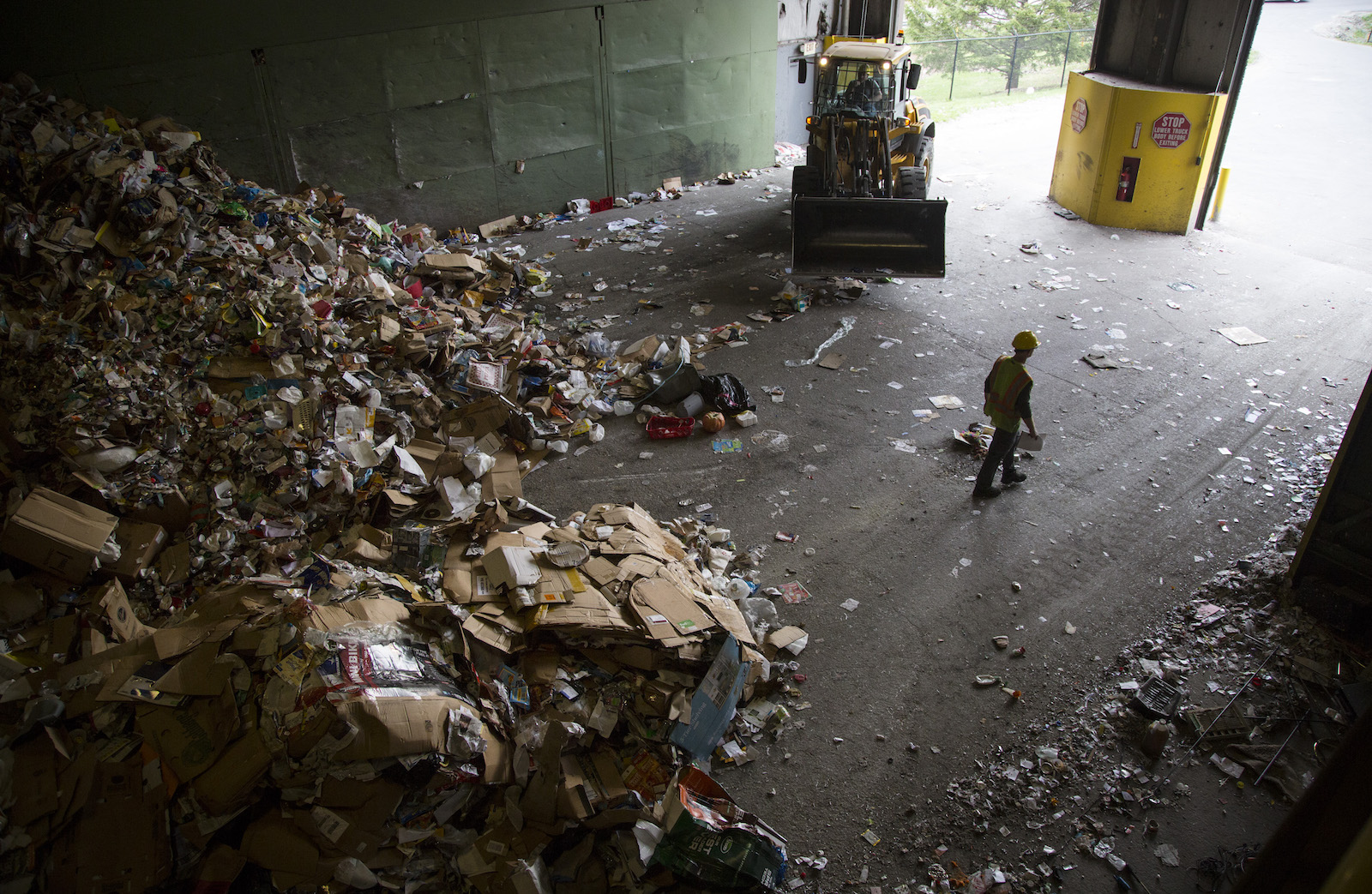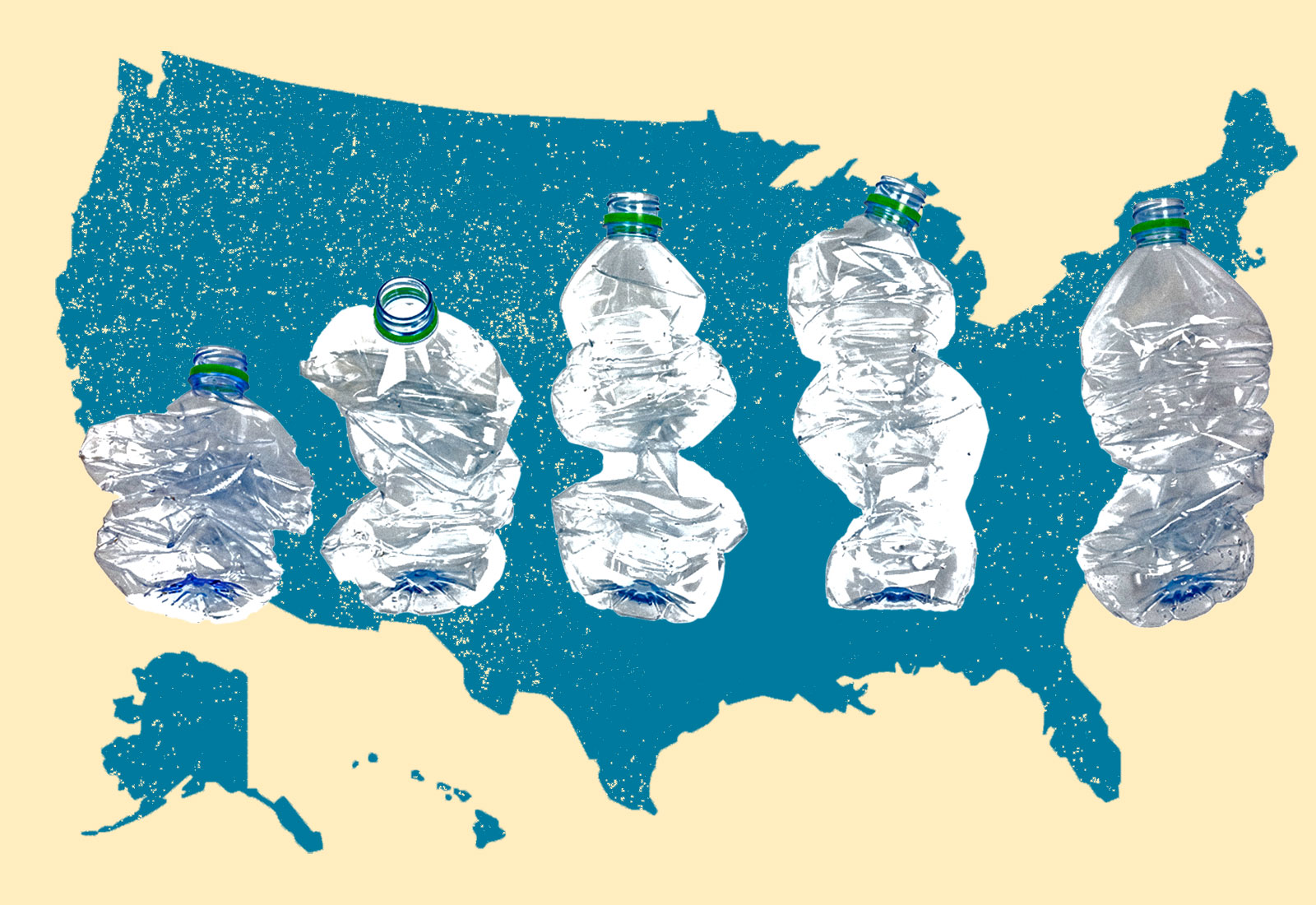If you’ve ever tossed a plastic water bottle in a trash can and felt a wave of guilt wash over you, well, judging by its marketing campaigns, that’s exactly how the packaging industry planned it.
Consider this recent public service announcement, where two uncanny squirrel puppets sit in a tree, watching passerby on the sidewalk and cheering when they put plastic bottles in the recycling bin. A man nearly throws a bottle in the trash (gasp!), but at the last moment, puts it away in his bag to “recycle later.” “Way to go, Mr. Brown Shoes!” one squirrel says. Then a message pops up on the screen: “Recycle your bottles like everyone’s watching.”
This ad is from Keep America Beautiful, a nonprofit backed by big corporations (think Coca-Cola, Pepsi, McDonald’s, Nestlé) that’s been delivering versions of that message for more than half a century. The focus has been on the litterbugs who tossed garbage on the ground, rather than on the companies manufacturing all that trash-to-be to begin with.
Countless mountains of plastic waste later, the tide is turning. There’s growing momentum behind the idea that companies should be held responsible for the waste they produce, instead of taxpayers. This summer, Maine and Oregon became the first states to pass laws making producers pay fees for this packaging. The resulting programs could reinvigorate recycling systems, often scaled back when cities look for ways to save money, and prompt big companies to come up with cleaner alternatives.
“This idea that these states are trying to shift that narrative into some other form of responsibility to make the producer pay, I think is really exciting and important as a development,” said Finis Dunaway, a professor of history at Trent University in Canada.
The Maine law, signed by Democratic Governor Janet Mills in July, requires producers to cover 100 percent of cities’ recycling costs. Companies will pay fees depending on a number of factors — like how much the packaging weighs and how easy it is to recycle — to an organization responsible for reimbursing cities and towns for their recycling operations. Oregon’s law, signed last month, will make companies pay for about 28 percent of the recycling costs, with municipalities handling the rest.
The state’s U.S. Senator, Jeff Merkley, a Democrat, reintroduced the Break Free From Plastic Pollution Act in Congress this year, along with Representative Alan Lowenthal, a Democrat from California. It would include a national program to make companies pay for the packaging they use. A handful of states considered similar bills this year, including Maryland, New York, Hawaii, California, Vermont, and Massachusetts. Although those bills didn’t pass, Yinka Bode-George, the environmental health manager at the National Caucus of Environmental Legislators in Washington, D.C., expects that some of them might succeed next year.
This trend was precipitated by a crisis in the recycling system. The United States used to sell much of its plastic waste to China, shipping it across the Pacific. But in 2017, China banned imports of many types of plastic and paper, and the market for recycling in the U.S. cratered. Dozens of cities ended up suspending or weakening their recycling programs. Materials dropped off for recycling now often head to the dump instead, or end up being incinerated, polluting the air with toxic compounds in mostly marginalized communities.

In Maine, cities and towns were discussing dropping their recycling programs after they’d become too expensive, said Sarah Nichols, the director of sustainability at the Natural Resources Council of Maine. The new law, she said, “could be the difference between having a recycling program and not.”
A recent report from the Global Alliance for Incinerator Alternatives found that across five major cities in the U.S., only 8.8 percent of the plastic that goes into garbage and recycling bins actually ends up getting recycled. And about 29 percent of soft drink and water bottles — made from polyethylene terephthalate, a fairly easy material to recycle — gets recycled in the United States, according to the Environmental Protection Agency. That’s not to say recycling is pointless, but rather that there are larger problems than the squirrel PSA implies. “When you look at the scale of this issue, we can’t, as consumers, recycle our way out of this. We don’t even have strong enough systems to,” Bode-George said. “And [companies] really need to step up and fund our systems so that they can operate adequately.”
The “Plastic Age” was once a promising vision of the future. Right before World War II, some dreamed that this material, so cheap to produce and so flexible in application, would bring abundance to the world. “Let us try to imagine a dweller in the ‘Plastic Age,’” wrote Victor Yarsely and Edward Couzens, two British chemists, in the magazine Science Digest in 1941. “This ‘Plastic Man’ will come into a world of colour and bright shining surfaces … a world in which man, like a magician, makes what he wants for almost every need.”

Instead, plastic became a catastrophe of its own. Of the billions of tons of plastic manufactured since the 1950s, only 9 percent was ever recycled, and 12 percent incinerated. (This would not come as much of a surprise to plastic producers, who knew for decades it was unlikely that most plastic would ever be economically viable to recycle.) The rest of that plastic remains all around us, threatening what one 2017 study called a “near permanent contamination of the natural environment,” as well as a global health crisis. And it’s likely to keep growing: Over the next two decades, plastic production is expected to double, according to The World Economic Forum. It’s also Plan B for Big Oil. Petroleum is the basic ingredient in all those plastic trash bags and toothbrushes. As countries shift away from fossil fuels to stave off the worst effects of climate change, oil companies see a future in plastic production.
Plastic exploded in popularity after World War II, as Susan Freinkel writes in the book Plastic: A Toxic Love Story, with Tupperware, vinyl siding, Barbies, and other items becoming the backdrop of life. Alongside the proliferation of disposable materials came the advent of anti-litter advertisements focused on individual responsibility. Keep America Beautiful — founded in 1951 by the American Can Company and the Owens-Illinois Glass Company, a glass bottle manufacturer — sought the help of the Advertising Council, known for creating Smokey Bear and coining the slogan “Only You Can Prevent Forest Fires.” Their early advertisements in the 1960s featured “Susan Spotless,” a white girl in a white dress who would wag her finger at her parents when they fouled public spaces with their litter.
Around the time of the first Earth Day demonstration in 1970, when an estimated 20 million Americans joined the events, the industry knew it had a problem. When demonstrators showed up at the Coca-Cola headquarters in Atlanta with a pickup truck brimming with bottles and cans, the plant managers were ready, with trash cans already set up and free drinks for demonstrators. The activists’ legitimate concerns about consumerism and the environmental effects of disposable packaging, Dunaway said, were met with the sentiment “Let them drink Coke.”
“They were becoming acutely aware that their industry was under attack,” Dunaway said. “They weren’t wrong about that.”
Keep America Beautiful began incorporating environmental themes into their advertisements. The famous “Crying Indian” ad, released on the first anniversary of Earth Day in 1971, portrays a Native American man (actually an Italian-American actor) paddling a canoe along the water. When someone driving nearby throws a bag of trash out the window, fast-food wrappers land on his moccasins, and the camera zooms in on the man’s face as he sheds a single, dramatic tear. “People start pollution,” a voiceover says. “People can stop it.”
By 1990, individual action had become the default answer to solving environmental problems, one low-flow showerhead at a time. The slogan of the year’s Earth Day events was “Who says you can’t change the world?” That same year, a concept known as “extended producer responsibility,” or EPR, was conceived across the ocean in Sweden. An academic named Thomas Lindquist proposed that product manufacturers and distributors should be held responsible for dealing with the waste from their products.
Over the years, extended producer responsibility laws have been applied to batteries, paint, old medicine, and, in much of the world, plastic packaging. While it’s new territory for the United States, nearly 50 countries already have EPR programs for packaging, including almost all of the European Union, Japan, South Korea, Brazil, Cameroon, Australia, and many Canadian provinces. Laws like these have had concrete results: South Korea, for example, saw its recycling rate double in the first 10 years of its EPR program that began in 2003; likewise, Ireland’s recycling rate more than tripled from 2000 to 2017.
Companies may put up a fight as these laws begin to take hold in the United States. The American Institute for Packaging and the Environment, a group that includes 3M, Campbell’s, the Dow Chemical Company, Procter & Gamble, McCormick, and Kellogg’s, argues that the recently passed Maine and Oregon laws gave the government too much control, and companies too little. In Maine, the group supported a competing bill that would have given companies more oversight of the program and exempted many pharmaceutical products as well as items like paint thinners and cleaning products.

The industry also claims that EPR bills will raise prices for groceries, citing a study that concluded Maine’s bill would lead companies to pass on all of the cost to consumers and make the average family of four spend an extra $32 to $59 on groceries every month. Nichols called the study “bogus,” pointing out that the author, Calvin Lakhan of York University in Toronto, leads a project that reportedly took hundreds of thousands of dollars from Clorox Canada and other companies. Lakhan told Politico that no company influenced his research, but admitted that the quality of the data he used from Ontario’s extended producer program was “extraordinarily poor,” and that companies probably wouldn’t pass on all the costs to consumers. For comparison, an analysis by the Oregon Department of Environmental Quality looking at EPR programs in Canada found that they nudged up prices by $0.0056 per item.
Still, Nichols said, it’s progress that many companies are at least beginning to acknowledge they have some responsibility. “At least we’re arguing more over like, ‘What should it look like?’ and not like ‘Should you be responsible or not?’” Nichols said. “I feel like that’s really changed.”
Bode-George from the National Caucus of Environmental Legislators says that the momentum from implementing these laws could open the doors for more ambitious legislation. In May, Washington state passed a law requiring the use of more recycled content in plastic beverage containers, and Colorado recently joined a growing number of states in banning plastic bags and polystyrene takeout containers. California is expected to pass legislation to make recycling more transparent by banning the three-arrow recycling symbol from products that aren’t actually recyclable (which is a lot of them — you can thank the plastics industry for that, too).
“For the longest time, you know, we put our plastic bottles into the recycling bin and assumed it would be recycled,” Bode-George said. “I think this push for EPR really signifies the fact that the veil has been lifted.”



